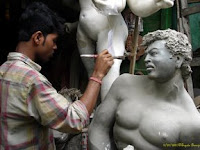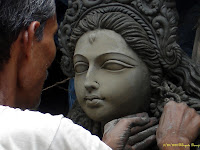Legs aching due to hours and hours of 'pandel-hopping' on foot, eardrums throbbing with the way-above-65-decibels sound of the 'dhak', eyes watering from the billowing smoke of the burning 'dhuno' (incense), and heart heavy with the thought of Her imminent departure: this was my condition as I sat in my colony Pujo pandel during the Nabami (20th October) evening 'arati'. And yet I was immensely enjoying every moment of it.
This year I enjoyed Pujo a lot. My pandel-hopping started on Panchami itself, as I wrote in my previous post. On Shashthi morning I took my sister to see some of the pandels in North Kolkata. We visited Kumortuli, Kumortuli Park, Baghbazaar, Shovabazaar and the Shovabazaar Palace. Kumortuli had the best idols. Kumortuli Park was the worst, I dare say. They had worked upon an idea that nobody would comprehend, and implemented it in the most viewer-unfriendly fashion possible. Pushing through the crowds on tiny viewing balconies, you could just manage to look down into a huge dark cylindrical chamber with water below. The bronze coloured statue was placed below there. I deliberately used the word 'statue' rather than 'idol'. Ten goddesses with two hands each hardly compensate for one with ten hands. And where were Her children?
Baghbazar Sarbojonin had their typical traditional idol. One strange thing that happened was that I met the gentleman whom I had photographed taking photographs of the flooded streets a few weeks ago. We talked this time. He is indeed a photojournalist. The Shovabazaar Palace Pujo is celebrating its 250th year this year. It had the atmosphere of a typical home pujo. I took a lot of photographs at all the places.
The evening was devoted to Salt Lake. We walked and we walked until we could walk no more. AG Block, AB Block, BE Block (East) and Labony were good among the ones that we saw. BD had a green coloured idol bathed in green light and it looked positively odd. About the so-called "Harry Potter themed FD Block Pandel", well, the less we say the better. If Rowling saw what they had done with her characters, she would probably disown them. Dumbledore in muggle clothes! Gah! What will we see next?
On Saptami morning we left for Hooghly. The rest of my holidays were spent in my hometown. Here too, we walked a lot. The pandels worth mentioning are Hooghly Beguntala (better than anything I saw in Kolkata this year), Rathtala, 3 No. Gate, Chinsurah Akhanbazaar and Peyarabagan. The Peyarabagan idol was a magnificent affair completely made of wood. Again, I took a lot of photos which can be seen here.

But the most time was spent in Mitrabagan, my locality. As I wrote before, it was almost like a home Pujo... my mother cooked the bhog everyday, we contributed flowers from our garden, when we did not like the music being played we took CDs from our house and played them instead. The best part of this Puja is the lack of the outside crowd. The whole colony ate bhog together on the Nabami afternoon. We spent the evenings in peace, sitting or standing at the pandel. Peace, of course, means amidst dhak-beats and dhuno fumes.
The days passed quickly... a bit too quickly. Soon I was standing in front of Ma Durga on the Dashami evening. She was about to be given a grand farewell by the ladies of the colony. I spent the last two Pujos at Hyderabad. Who knows where I'll be next year? I looked at her face closely, trying to take in every detail. I'll see her only in these memories for some time to come.
Since yesterday I'm back at work as usual. The Internet was slow, so I couldn't upload the photos earlier, and the post got delayed accordingly. I'll be busy this week visiting relatives' houses and touching their feet for Bijoya and earning sweets in the process. See you after that.
Ah yes, I wish all of my readers and their families a Very Shubho Bijoya!
This year I enjoyed Pujo a lot. My pandel-hopping started on Panchami itself, as I wrote in my previous post. On Shashthi morning I took my sister to see some of the pandels in North Kolkata. We visited Kumortuli, Kumortuli Park, Baghbazaar, Shovabazaar and the Shovabazaar Palace. Kumortuli had the best idols. Kumortuli Park was the worst, I dare say. They had worked upon an idea that nobody would comprehend, and implemented it in the most viewer-unfriendly fashion possible. Pushing through the crowds on tiny viewing balconies, you could just manage to look down into a huge dark cylindrical chamber with water below. The bronze coloured statue was placed below there. I deliberately used the word 'statue' rather than 'idol'. Ten goddesses with two hands each hardly compensate for one with ten hands. And where were Her children?
Baghbazar Sarbojonin had their typical traditional idol. One strange thing that happened was that I met the gentleman whom I had photographed taking photographs of the flooded streets a few weeks ago. We talked this time. He is indeed a photojournalist. The Shovabazaar Palace Pujo is celebrating its 250th year this year. It had the atmosphere of a typical home pujo. I took a lot of photographs at all the places.
The evening was devoted to Salt Lake. We walked and we walked until we could walk no more. AG Block, AB Block, BE Block (East) and Labony were good among the ones that we saw. BD had a green coloured idol bathed in green light and it looked positively odd. About the so-called "Harry Potter themed FD Block Pandel", well, the less we say the better. If Rowling saw what they had done with her characters, she would probably disown them. Dumbledore in muggle clothes! Gah! What will we see next?
On Saptami morning we left for Hooghly. The rest of my holidays were spent in my hometown. Here too, we walked a lot. The pandels worth mentioning are Hooghly Beguntala (better than anything I saw in Kolkata this year), Rathtala, 3 No. Gate, Chinsurah Akhanbazaar and Peyarabagan. The Peyarabagan idol was a magnificent affair completely made of wood. Again, I took a lot of photos which can be seen here.

But the most time was spent in Mitrabagan, my locality. As I wrote before, it was almost like a home Pujo... my mother cooked the bhog everyday, we contributed flowers from our garden, when we did not like the music being played we took CDs from our house and played them instead. The best part of this Puja is the lack of the outside crowd. The whole colony ate bhog together on the Nabami afternoon. We spent the evenings in peace, sitting or standing at the pandel. Peace, of course, means amidst dhak-beats and dhuno fumes.
The days passed quickly... a bit too quickly. Soon I was standing in front of Ma Durga on the Dashami evening. She was about to be given a grand farewell by the ladies of the colony. I spent the last two Pujos at Hyderabad. Who knows where I'll be next year? I looked at her face closely, trying to take in every detail. I'll see her only in these memories for some time to come.
Since yesterday I'm back at work as usual. The Internet was slow, so I couldn't upload the photos earlier, and the post got delayed accordingly. I'll be busy this week visiting relatives' houses and touching their feet for Bijoya and earning sweets in the process. See you after that.
Ah yes, I wish all of my readers and their families a Very Shubho Bijoya!





